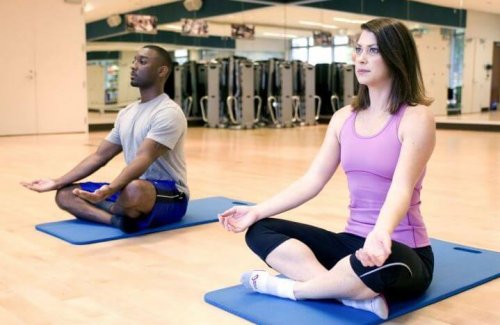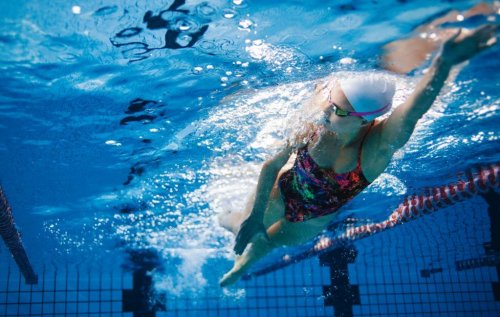The 4 Ways of Breathing and their Benefits

Respiration is one of our body’s many automatic responses. Along with blinking, these responses are the only ones that we can consciously control. It’s also a clear indication of our mood and even our health. Below are four ways of breathing and their benefits.
You might like: How breathing affects our concentration
The technique of knowing how to breathe
The way newborns breathe (except for those with complications), tends to be used to illustrate how this process is performed to perfection. In a totally automatic way, babies take in all the oxygen they need with each breath, with the ideal rhythm and frequency.
In the different stages following early infancy, during growth and development, this natural habit of respiration is replaced with bad habits.
Yawning and sighing: a red flag
The brain, in order to function optimally, requires 20 percent of the oxygen that enters the lungs during each inhalation. If there isn’t enough air, the “central computer” goes into deficit.
Yoga is one of the ways we can work on our breathing. When we yawn or sigh, it’s a way for our body to correct an error in our breathing. These are involuntary responses that can temporarily increase O2 levels and allow our brains to stay operational. However, they only work as a temporary relief.
You might like: Ten Reasons to Practice Yoga Every Day

Step 1: be aware of your breathing
Before performing any exercises with the goal of optimizing this process, you must take a few minutes to observe and evaluate how you are breathing.
The best way to complete such a diagnosis is with the following: lay down on your back, sitting with your back straight, or standing, place a hand on your chest. Place the other hand on your diaphragm, or the upper part of your abdomen.
If, when you inhale, as naturally as possible without forcing air in, only the hand on your chest moves, there’s actually a problem. The hand that’s placed below your lungs should rise first. Ideally, both hands should move: first, the one below and second, the one on your chest.
Four ways of breathing
1. Superficial
Also called clavicular or high breathing, in superficial respiration the inhaled air doesn’t reach beyond the uppermost part of the lungs. As the blood and brain are receiving less oxygen, all tissues could be in jeopardy.
Despite the aforementioned, this way of breathing has its advantages: as it provides the body with oxygen very quickly, it’s useful during short bursts of high-intensity exercise.

2. Deep or abdominal
In deep or abdominal breathing, the diaphragm comes into play. You must inhale slowly through your nose and direct all of your breath towards your abdomen. To expel the air, you must take as much time as you did during inhalation.
Deep breaths strongly facilitate relaxation and concentration. Additionally, it can help lower levels of anguish and relieve stress and anxiety. With practice, this will become more automatic.
3. Intercostal
The objective here is to direct your breath towards the central zone of the thorax and to the sides of the lungs. During these exercises, inhale and exhale as slowly and carefully as possible. The most important benefit of breathing this way is that when you expand the thoracic cavity, you increase your lung capacity.
4. Full
As its name suggests, full breathing occurs when the lungs reach maximum capacity. Upon this happening, almost immediately, you will feel a strong state of relaxation and concentration. In the same way, your heart rate and your blood pressure will also decrease.
Unlike deep breathing, automatization of the full breath is practically impossible. It’s even difficult to begin practicing the exercises involving full breathing. The objective is to work your lungs to their full capacity, which can be a bit difficult at first.
Final Considerations
These exercises for practicing deep, intercostal and full breathing can be performed standing up, sitting down with your back straight, or laying down face up. However, these exercises should preferably be done in a calm environment and away from extreme temperatures.
For athletes, using the correct breathing technique is as important as maintaining adequate hydration and a balanced diet. If it’s is not done correctly, the muscles are not properly prepared to prevent injury.
Respiration is one of our body’s many automatic responses. Along with blinking, these responses are the only ones that we can consciously control. It’s also a clear indication of our mood and even our health. Below are four ways of breathing and their benefits.
You might like: How breathing affects our concentration
The technique of knowing how to breathe
The way newborns breathe (except for those with complications), tends to be used to illustrate how this process is performed to perfection. In a totally automatic way, babies take in all the oxygen they need with each breath, with the ideal rhythm and frequency.
In the different stages following early infancy, during growth and development, this natural habit of respiration is replaced with bad habits.
Yawning and sighing: a red flag
The brain, in order to function optimally, requires 20 percent of the oxygen that enters the lungs during each inhalation. If there isn’t enough air, the “central computer” goes into deficit.
Yoga is one of the ways we can work on our breathing. When we yawn or sigh, it’s a way for our body to correct an error in our breathing. These are involuntary responses that can temporarily increase O2 levels and allow our brains to stay operational. However, they only work as a temporary relief.
You might like: Ten Reasons to Practice Yoga Every Day

Step 1: be aware of your breathing
Before performing any exercises with the goal of optimizing this process, you must take a few minutes to observe and evaluate how you are breathing.
The best way to complete such a diagnosis is with the following: lay down on your back, sitting with your back straight, or standing, place a hand on your chest. Place the other hand on your diaphragm, or the upper part of your abdomen.
If, when you inhale, as naturally as possible without forcing air in, only the hand on your chest moves, there’s actually a problem. The hand that’s placed below your lungs should rise first. Ideally, both hands should move: first, the one below and second, the one on your chest.
Four ways of breathing
1. Superficial
Also called clavicular or high breathing, in superficial respiration the inhaled air doesn’t reach beyond the uppermost part of the lungs. As the blood and brain are receiving less oxygen, all tissues could be in jeopardy.
Despite the aforementioned, this way of breathing has its advantages: as it provides the body with oxygen very quickly, it’s useful during short bursts of high-intensity exercise.

2. Deep or abdominal
In deep or abdominal breathing, the diaphragm comes into play. You must inhale slowly through your nose and direct all of your breath towards your abdomen. To expel the air, you must take as much time as you did during inhalation.
Deep breaths strongly facilitate relaxation and concentration. Additionally, it can help lower levels of anguish and relieve stress and anxiety. With practice, this will become more automatic.
3. Intercostal
The objective here is to direct your breath towards the central zone of the thorax and to the sides of the lungs. During these exercises, inhale and exhale as slowly and carefully as possible. The most important benefit of breathing this way is that when you expand the thoracic cavity, you increase your lung capacity.
4. Full
As its name suggests, full breathing occurs when the lungs reach maximum capacity. Upon this happening, almost immediately, you will feel a strong state of relaxation and concentration. In the same way, your heart rate and your blood pressure will also decrease.
Unlike deep breathing, automatization of the full breath is practically impossible. It’s even difficult to begin practicing the exercises involving full breathing. The objective is to work your lungs to their full capacity, which can be a bit difficult at first.
Final Considerations
These exercises for practicing deep, intercostal and full breathing can be performed standing up, sitting down with your back straight, or laying down face up. However, these exercises should preferably be done in a calm environment and away from extreme temperatures.
For athletes, using the correct breathing technique is as important as maintaining adequate hydration and a balanced diet. If it’s is not done correctly, the muscles are not properly prepared to prevent injury.
All cited sources were thoroughly reviewed by our team to ensure their quality, reliability, currency, and validity. The bibliography of this article was considered reliable and of academic or scientific accuracy.
- Speads, C. (1992). Ways to better breathing. Inner Traditions/Bear & Co.
- Jerath, R. Edry, J.W. Barnes, V. A. & Jerath, V. (2006). Physiology of long pranayamic breathing: neural respiratory elements may provide a mechanism that explains how slow deep breathing shifts the autonomic nervous system. Medical hypotheses, 67(3), 566-571.
This text is provided for informational purposes only and does not replace consultation with a professional. If in doubt, consult your specialist.








